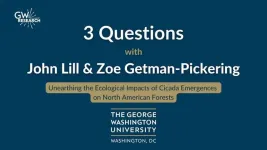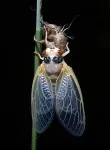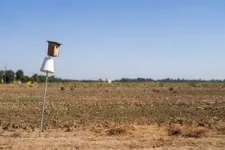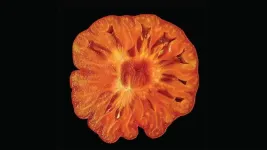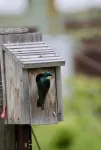(Press-News.org) WASHINGTON (October 19, 2023) – Every 13 or 17 years, billions of cicadas emerge from the ground to reproduce in eastern North American deciduous forests. One of the largest emergence events of these insects happened in 2021 when theBrood X cicadas emerged. Researchers who studied that once-in-a-generation event are now unveiling the impact this occurrence had on forest ecosystems, specifically on birds, caterpillars and trees.
In a new study published today in Science, researchers at the George Washington University, Georgetown University and the University of Maryland quantified the widespread changes the 2021 periodical cicada emergence had on the feeding patterns of birds and its downstream effects. The research team says this is one of only a few studies that has explored the indirect effects of periodical cicada emergence events on forest food webs.
The study finds that more than 80 species of birds opportunistically switched their diets to cicadas during their emergence. That feeding frenzy on cicadas relieved some of the predatory pressure on the birds’ typical prey, forest caterpillars, which consequently increased in abundance, resulting in more leaf damage on their host oak trees. Researchers collected their data at two study sites in the Mid-Atlantic portion of the Brood X range in the United States.
“Our findings really show how interconnected these ecosystems are, how plants, animals and all sorts of organisms are all deeply connected. When you shift the behavior or the population of one of those organisms, the effects ripple through the ecosystem in surprising ways,” Zoe Getman-Pickering, first author and former postdoctoral researcher at GW, says. “I think it’s important to remember that as humans are impacting the ecosystem – through climate change, through development of natural areas, through the introduction of invasive species – we are altering complex foodwebs in surprising ways.”
Periodical cicada emergence events only last for about five to seven weeks. The research team collected data before, during, and after the cicada emergence, deploying decoy caterpillars to track bird feeding patterns. They also recruited the help of the broader birding community to crowdsource additional observational data about which birds were feeding on cicadas. In addition to the clay decoy caterpillars, the researchers counted the number of caterpillars on oak trees during the emergence and measured the subsequent damage they caused to the leaves of their host trees.
Not only do these massive emergence events help scientists better understand how a sudden influx of a particular food source can rewire complex food chains and disrupt forest ecosystems, the study authors say their findings have larger implications for bird conservation.
“Birds are a really important regulator of insect herbivores and the amount of damage that plants receive. Over the last several decades, there’s been a significant decline in bird populations,” John Lill, study co-author and a professor of biology at GW, says. “Our study provides a glimpse of what a world with fewer birds might look like. That would include increased damage to both forestry and agricultural crops, which has consequences for productivity and the economy.”
The research team suggests that their findings related to the ecological consequences of the cicada emergence may represent a more general, though little-studied, pattern.
"Whenever a big resource pulse, like the annual bonanza of salmon eggs in inland streams, or horseshoe crab eggs in the Delaware Bay, alters the diets of generalist predators in a region, ecologists should take a look at the changes in the foodweb that occur when the typical prey temporarily escapes predation.” Martha Weiss, study co-author and a professor of biology at Georgetown, says.
Scientists are anticipating a historical convergence of two broods of periodical cicadas, Brood XIII and Brood XIX, that are scheduled to emerge at the same time in the Midwest in the spring of 202, an event that last occurred in 1803. The research team plans to continue exploring the indirect impacts of cicadas on other parts of the forest foodweb.
WATCH: Hear more about this research, its key findings, and the implications it has for larger ecosystem conservation efforts in this video here.
The paper, “Periodical Cicadas Disrupt Trophic Dynamics through Community-level Shifts in Avian Foraging,” was published in Science. This research was funded by research grants from the George Washington University Facilitating Fund, the Earth Commons: Georgetown University’s Institute for Environment and Sustainability, and the Washington Biologists Field Club.
[Note: High-resolution images related to this research are available for download at this link. Caption and credit information provided.]
-GW-
END
Maximum temperature extremes reduce the nesting success of birds across the United States by nearly 50% in agricultural landscapes but not forests, according to a new study based on more than 20 years of citizen-science nest-monitoring data. The findings show that future warming may exacerbate the negative effects of habitat conversion on bird fitness, especially among species of conservation concern in human-dominated landscapes. Habitat conversion and climate change are fundamental drivers of biodiversity loss worldwide. However, ...
An unusually high-energy fast radio burst (FRB) from a high-redshift galaxy has offered new insights into the distant universe, challenging current models of FRB emission. The findings also help constrain key attributes of these astrophysical phenomena. FRBs are brief pulses of radio emission originating from distant extragalactic sources. Although the astrophysical processes that cause FRBs aren’t fully understood, the signals they produce can be used to infer information about the cosmic environments they pass through as they travel across the universe, including the nature of ...
Researchers present NorthPole – a brain-inspired chip architecture that blends computation with memory to process data efficiently at low-energy costs. Since its inception, computing has been processor-centric, with memory separated from compute. However, shuttling large amounts of data between memory and compute comes at a high price in terms of both energy consumption and processing bandwidth and speed. This is particularly evident in the case of emerging and advanced real-time artificial intelligence (AI) applications like facial recognition, object detection, and ...
The periodical mass emergence of cicadas in eastern North American forests can “rewire” forest food webs and initiate a cascade of ecological impacts that propagates throughout the food chain, according to a study that quantified effects of the 2021 Brood X cicada emergence. The study found that when insect-eating birds have abundant prey in the form of cicadas and thus shift their focus away from their usual repast – leaf-eating caterpillars – the caterpillars feast more heavily upon the leaves of oak saplings, doubling insect leaf damage. “Although previous studies have documented strong ecological ...
For tens of thousands of years, evolution shaped tomatoes through natural mutations. Then, humans came along. For centuries, we’ve bred and cherry-picked tomatoes with our preferred traits. Today, CRISPR genome editing allows us to make new crop mutations that improve traits even further. However, individual mutations, whether natural or engineered, don’t work alone. Each operates in a sea of thousands of so-called “background” mutations. These changes have been sowed by evolution and agricultural ...
Bird populations are in rapid decline across North America. While climate change is just one of the many factors influencing North American birds, its effects are significant and can interact with other stressors, such as habitat loss. A team of University of California, Davis, researchers found that the effects of extreme temperatures on avian reproduction can vary depending on the type of environment that birds call home.
The findings, published in the journal Science, shed light on how climate change can combine with habitat loss to affect bird reproduction ...
An international team has spotted a remote blast of cosmic radio waves lasting less than a millisecond. This 'fast radio burst' (FRB) is the most distant ever detected. Its source was pinned down by the European Southern Observatory’s (ESO) Very Large Telescope (VLT) in a galaxy so far away that its light took eight billion years to reach us. The FRB is also one of the most energetic ever observed; in a tiny fraction of a second it released the equivalent of our Sun’s total emission over 30 years.
The discovery of the burst, named FRB 20220610A, was made in June last year by the ASKAP radio telescope in Australia ...
Whether a mouse is a good or bad parent can be traced back to imprinted genes in key neurons in the “parenting hub” in the brain, according to a new study by Anthony Isles of Cardiff University and colleagues, published October 19 in the journal PLOS Genetics.
In mice, there is some evidence that an unusual phenomenon in mammals called genomic imprinting impacts parenting behavior. Mammals inherit two copies of each gene – one from each parent – and usually, each copy is expressed equally in the cell. With imprinted genes, however, only one copy is expressed, ...
With smartphone videos, clinicians can analyze human movement using open source "OpenCap" platform, 25x faster and at a fraction of the cost of labs.
####
Article URL: https://journals.plos.org/ploscompbiol/article?id=10.1371/journal.pcbi.101XXXX
Article Title: OpenCap: Human movement dynamics from smartphone videos
Author Countries: US
Funding: SDU, AF, LK, JM, ASC, JLH, and SLD were supported by the National Institutes of Health (https://www.nih.gov; grant 1P41EB027060-01A1) and the Wu Tsai Human Performance Alliance (https://humanperformancealliance.org). ASC and MK were supported by Philips Healthcare (https://www.usa.philips.com/healthcare) ...
WHAT:
A research team funded by the National Institutes of Health has developed a smart phone app that can track and analyze a person’s ability to move from one place to another, known as locomotion, and other types of movements. Human motion analysis is used to evaluate patients with movement difficulties, to help clinicians plan surgery, and to assess the results of treatment procedures. The research team believes that using the app costs about 1% of conventional motion analysis techniques and works 25 times faster. The study appears in PLOS Computational Biology.
Researchers tested their app, called OpenCap, with 100 participants. Using two or more smart phones, ...
